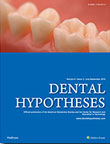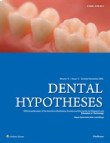فهرست مطالب

Dental Hypotheses
Volume:6 Issue: 3, Jul-Sep 2015
- تاریخ انتشار: 1394/06/11
- تعداد عناوین: 10
-
-
Pages 79-81IntroductionNanobacteria are mysterious particles that have spurred one of the biggest controversies in modern microbiology. The apatite mineral around the nanobacteria serves as a primary defense shield against various chemicals and extremely harsh condition. It is combined with a very slow metabolism of nanobacteria. These two items would be the likely explanation for the sever resistance of nanobacteria. The Hypothesis: The CO 2 laser is a continuous wave gas laser and emits infrared light at 9,600-10,600 nm in an easily manipulated focused beam that is well absorbed by water and hydroxyapatite. Hence, it seems logical to postulate that CO 2 laser can be used successfully to destroy defensive external hydroxyapatite layer of nanobacteria. Evaluation of the Hypothesis: Main criticism with this hypothesis is differential radiation of nanobacteria. It is well known that CO 2 laser has high water absorption and consequently can cause unwanted damage to human host tissues.
-
Pages 82-85IntroductionNowadays, cracked tooth syndrome is the third main cause of tooth extraction, following caries and periodontal diseases, done in almost all the dental clinics. Nevertheless, the diagnosis and treatment of this condition remain controversial. All candidate therapeutics, such as occlusal adjustment, preventive filling, root canal therapy (RCT), and crown restoration, provide unpredictable outcomes. As such, methods to prevent further crack development and to induce crack self-healing must be developed. The Hypothesis: Mussels secreting adhesive foot protein (Mafp) can attach to various surfaces under aqueous conditions. In nature, mussels adhere to stones and deposit layer by layer through mineralization, thereby forming mussel-stone composites with excellent mechanical property. Given the natural process of mussel-stone complex formation, we hypothesize that application of Mafp coating at the crack interface may mineralize the cracks by capturing calcium and phosphate ions from the saliva. This process consequently leads to crack self-healing and complete restoration of the tooth structure. Evaluation of the Hypothesis: To test our hypothesis, we need to develop a model in vivo. Cracked teeth disks are adhered together using Mafp solution. Then, the tooth disks are sutured on the interior side of the cheeks. After regular intervals, the disks are removed and characterized. Scanning electron microscopy is performed to evaluate the morphology of the crack interface. Microhardness and shear bond strength are used to evaluate the mechanical property of the healing cracked zone. Transmission electron microscopy is also conducted to evaluate the crystallinity of the crack interface.
-
Pages 86-93IntroductionCommercial dental resin composites under the same shade designations show color discrepancies by brand. Moreover, three Commission Internationale de l''Eclairage (CIE) color coordinates show significant variations by measurement method; therefore, direct comparisons of the color coordinates based on different methods are meaningless. This study aimed to assess a hypothesis that a new color attribute index (CAI), which could reduce the color coordinate variations by measurement method, was applicable for the shade conformity judgment of dental resin composites. The Hypothesis: CAI is applicable in the shade conformity judgment of commercial dental resin composites. Using the CIE color coordinates of shade guide tabs and resin composites, combined color indices such as Wa = CIE a* × DE* ab /C ab * and Wb = CIE b* × DE* ab /C ab * were defined, in which DE* ab was the color difference with a standard white tile. Ratio of Wa/Wb to that of an arbitrary reference shade (A2) in the same brand and measurement was defined as the CAI. The CAI values were significantly different by the shade designation and showed a logical trend by the shade designation number. The CAI of commercial resin composites and the keyed shade guide tabs showed overlaps. Evaluation of the Hypothesis: The CAI might be used to judge the shade conformity of resin composites using the values based on different measurement methods. The application of the CAI, instead of conventional three-color coordinates, could efficiently simplify the shade conformity judgment of commercial resin composites. Although the hypothesis of the present study was partially confirmed, further studies for the practical application of this index are highly recommended.
-
Pages 94-96IntroductionDentofacial functional appliances used for the treatment of skeletal Class II malocclusion are divided into two groups: Removable appliances and fixed (bonded) appliances, each with certain advantages and disadvantages. Considering the problems related to functional appliances such as high volume in the oral cavity, patient noncompliance, esthetics, tissue irritation or ulceration, speech or breathing difficulties, etc., there is considerable demand to develop a new appliance that can overcome these issues. Thus, the aim of the current study is to present a hypothesis regarding a new functional treatment technique. The hypothesis: We hypothesize that by fixing mini-plates or -implants in the posterior region of the mandible and the anterior part of the infrazygomatic crest region of the maxilla using intermaxillary elastics, we can expect a forward growth of the mandible in a growing child. Using this technique, the force vector will be in the oblique (forward-upward) direction. By installing mini-plates with a long connecting bar in the infrazygomatic crest region (with the orthodontic attachment head approximating the level of the occlusal plane), and mini-plates or -implants in the most posterior and superior regions of the mandible, such as the retromolar region, the force vector can be placed in the most horizontal direction possible. Evaluation of the hypothesis: In the literature, significant growth modification results were reported in skeletal Class III patients using intermaxillary elastics and bone-anchored devices fixed in both jaws, when compared with those in the nontreatment group. Therefore, in practice, intermaxillary elastics can produce enough traction to stimulate the bone to change and grow. Thus, we presume that inverting the direction of the force vector (i.e., posterior-anterior force) may have similar growth effects on the mandibles of growing children.
-
Pages 97-103IntroductionTo determine the diagnostic accuracy of cone beam computed tomography (CBCT) in the detection of simulated mandibular condyle erosions.Materials And MethodsSeventeen dry human mandibles were used in this in vitro study. NewTom VG CBCT scanner (New Tom VG, Verona, Veneto region, Italy) was used for the condyles imaging (pre-erosion and post-erosion image). Thirty three lesions were created on the superior (11 cases), anterior (11 cases), and posterior surfaces (11 cases) of the condyles. The pre- and post-erosion images were randomly presented to two previously calibrated oral and maxillofacial radiologists in order to evaluate the presence of simulated erosions and their position in the condyles using two protocols. In the first protocol, axial and coronal images and in the second protocol, axial, coronal, and sagittal/multiplanar reconstructed (MPR) images were used to evaluate the lesions of the samples. Furthermore, the Cochran''s Q test and McNemar and Kappa statistical tests were used to assess the sensitivity, specificity, and accuracy of this study.ResultsThere was no statistically significant difference between the diagnostic methods and the reference value. There was substantial agreement between the two protocols (Kappa > 0.61). Protocol 2 showed relatively better results than protocol 1 but the difference was not statistically significant (P > 0.05). Sensitivity, specificity, and diagnostic accuracy levels in the erosion imaging were higher in the posterior region of condyle; however, there was no statistically significant difference between the condylar regions (P > 0.05).ConclusionCBCT had high sensitivity, specificity, and diagnostic accuracy in the detection of simulated mandibular condyle erosions.
-
Analysis of reticulin fiber pattern in lymph nodes with metastasis from oral squamous cell carcinomaPages 104-108IntroductionThe aim of the study was to determine the susceptibility of lymph nodes to metastasis in oral squamous cell carcinoma (OSCC) by analyzing the alterations in reticulin fiber pattern.Materials And MethodsThis retrospective study on 30 cases of OSCC had 15 cases that presented with lymph node metastasis (test group) and 15 cases without metastatic episodes (control group). Four micron thick sections of the tumor proper and the resected lymph nodes of the cases were stained with hematoxylin and eosin, and Gordon and Sweet''s stain for reticulin. Statistical analysis of the variations in the staining patterns of reticulin at the invasive tumor front (ITF), involved and uninvolved lymph nodes were done with Statistical Package for Social Sciences (SPSS) 15 version using chi-square test.ResultsThe assessment of reticulin fiber patterns at the ITF, cortical and medullary areas of lymph nodes in test cases showed thin, long individual fibers, as compared to thick, shorter interlacing fibers that were seen in control cases. The peritumoral and uninvolved areas in metastatic lymph nodes of almost all test cases showed very scant fibers.ConclusionReticulin pattern alteration by aggressive tumors may be appreciated as a part of the wide spectrum of «proneoplastic» stromal alterations. The histopathologist can discern these changes and thereby aid the clinician in predicting tumor behavior, the clinical course of the disease, and weighing the prognostic implications.
-
Pages 109-116IntroductionThis study aims to evaluate the effects of different curing units and modes on the degree of conversion (DC) and microhardness (MH) of two different resin composites [ESTELITE ∑ QUICK (EQ), and Z350 XT (Z3)].Materials And MethodsOne hundred (100) discs of each tested material were made and divided into two subgroups (n = 50) according to the discs'' dimensions: 5 mm diameter × 2 mm thickness, and 2 mm diameter × 2 mm thickness. Each subgroup was further subdivided into the following five classes (n = 10): I) cured with halogen light curing-unit; II) cured with light-emitting diode (LED) unit; III) cured with argon laser; IV) cured with halogen light-curing unit for 5 s, 10 s rest followed by 20 s curing; and V) cured with halogen light-curing unit for 10 s, then 10 s rest, followed by 10 s curing. The first subgroup was tested for MH using the Vickers Microhardness tester and the second subgroup was tested for DC using Fourier transform infrared spectroscopy (FTIR). Data were statistically analyzed using two-way analysis of variance (ANOVA) and Tukey''s post hoc test P < 0.05.ResultsSpecimens in class IV showed the highest mean DC and MH, followed by class III, then class II. Class I showed significantly lower mean values for both DC and MH. On the other hand, Z3 showed statistically significantly higher mean DC and MH than EQ.ConclusionAlthough the two tested composites did not perform similarly under the test conditions, curing with halogen unit for 5 s, then 10 s rest, followed by 10 s curing improved the DC and the MH of both the tested materials.
-
Pages 117-122IntroductionMaxillary sinusitis can have various origins, including odontogenic origin. Case Report: We describe a case of maxillary sinusitis in a 25-year-old female patient who experienced pain and swelling in the right maxillary region as a complication of infected maxillary lateral incisor. Clinical and radiographic examinations revealed dens invaginatus (DI; Oehler''s type III) associated with apical pathosis in the maxillary right lateral incisor, with a large periapical lesion involving the adjacent four teeth. Nonsurgical root canal treatment using calcium hydroxide medicament was carried out for all five teeth, which resulted in gradual diminution of sinusitis, and the patient remained asymptomatic.DiscussionThis paper emphasizes the following: (i) the challenges posed by DI for root canal treatment because of its anatomical complexity; (ii) a nonsurgical approach in the management of a large periapical lesion, using calcium hydroxide medicament; and (iii) the interdisciplinary management of conditions of common clinical concern for medical and dental practitioners, for successful outcome.


